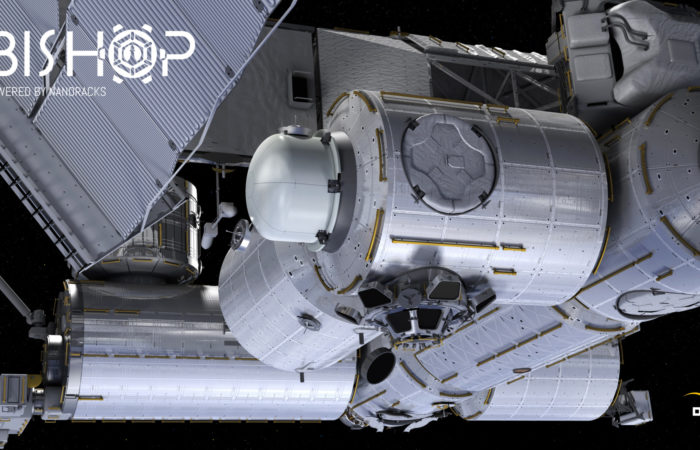April 17, 2018 – Colorado Springs, Colorado – The NanoRacks Space Station Airlock Module “Bishop” met another major milestone with completion of the Critical Design Review (CDR) on March 20 and 21, 2018 in Houston, Texas. This milestone begins the transition from the engineering design phase to the fabrication phase. Detailed design drawings such as those for the critical pressure shell will be signed and released to NanoRacks fabrication partner, Thales Alenia Space, in order for them to continue their fabrication efforts.
In February 2018, NanoRacks announced that Thales Alenia Space, the joint venture between Thales (67%) and Leonardo (33%), was chosen as the latest partner in its commercial airlock program, joining with a number of key partners, including Boeing.
Thales Alenia Space is set to produce and test the critical pressure shell for the NanoRacks Airlock Module and will also manufacture various secondary structures, including the Micrometeoroid Orbital Debris (MMOD) shields with Multi-Layer Isolation (MLI) panels, the power and video grapple fixture support structure and other structural components.
Other key features, such as the Passive Common Berthing Mechanism (PCBM), being manufactured by Boeing, require a long lead time and have been in production for over a year now. The PCBM will be delivered to Thales Alenia Space in May 2018 and will then be installed to the pressure shell.
“I’m very proud of the NanoRacks engineering team and our partner, ATA Engineering, who performs the structural and thermal analysis for Bishop,” says Airlock Project Manager Brock Howe. “This is a crucial milestone that required many long hours, and the team has been working together very smoothly. We’re also very appreciative of our relationship with NASA and the International Space Station Program Office, as they have provided guidance and expertise in several critical areas. As always, there is plenty of work still to do – and we will continue to push forward.”
The next major milestone is the Phase II Safety Review scheduled for June 2018. The project is still on track to meet the SpaceX CRS-19 launch, targeting fourth quarter 2019.
For continued updates, be sure to follow @NanoRacks on Twitter.
About NanoRacks
NanoRacks is enabling space research and in-space services to customers world-wide from multiple platforms and launch vehicles. The company offers low-cost, high-quality solutions to the most pressing needs for satellite deployment, basic and educational research and both at home and in 30 nations world-wide for those new to the industry and aerospace veterans. Since 2009, Texas-based NanoRacks has truly created new markets, and ushered in a new era of in space-services.
In July 2015, NanoRacks signed a teaming agreement with Blue Origin to offer integration services on their New Shepard space vehicle. NanoRacks, along with partners at ULA and Space Systems Loral was also selected by NASA to participate in the NextSTEPs Phase II program to develop commercial habitation systems in low-Earth orbit and beyond.
NanoRacks signed an additional Space Act Agreement with NASA in 2016 to install the first-ever private Airlock Module on the International Space Station. In February 2017, NanoRacks announced two partnerships with both Boeing and Thales Alenia Space to produce features of the Airlock.
As of April 2018, over 600 payloads have been launched to the International Space Station via NanoRacks services, and our customer base includes the European Space Agency (ESA) the German Space Agency (DLR,) the American space agency (NASA,) US Government Agencies, Spire, Millennium Space Systems, Space Florida, NCESSE, Virgin Galactic, pharmaceutical drug companies, and organizations in Vietnam, UK, Romania, Israel and beyond.
About ATA Engineering
ATA Engineering, an employee-owned small business, provides analysis- and test-driven design solutions focusing on the engineering needs of major manufacturers in addressing their cost, quality, and time-to-market engineering challenges for mechanical and aerospace systems. ATA uses advanced computer-aided engineering software to solve problems for customers in the aerospace, biomedical, automotive, entertainment, and consumer products industries.
Over its 39 years of operation, ATA has supported the design, analysis, and test of numerous launch vehicles, satellites, space structures, and aircraft. ATA is a recognized leader in the application of advanced methods for satisfying mechanical, structural, thermal, fluids, and acoustic design requirements for defense and aerospace structures at the component, subsystem, and system levels.
ATA’s emphasis on high-value engineering solutions through the use of innovative test and analysis approaches has been recognized with a number of technical and service awards for excellence—including the George M. Low Award, which is NASA’s premier quality and performance award for prime and subcontractors.

